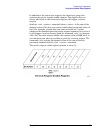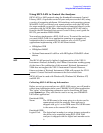
88 Chapter 2
Programming Fundamentals
Using the Instrument Status Registers
In addition to the standard event status register, the standard event
status group also contains a standard event status enable register. This
register lets you choose which bits in the standard event status register
will set the summary bit (bit 5 of the status byte register) to 1. Send the
*ESE <number> command where <number> is the sum of the decimal
values of the bits you want to enable. For example, to enable bit 7 and
bit 6 so that whenever either of those bits is set to 1, the standard event
status summary bit of the status byte register will be set to 1, send the
command *ESE 192 (128 + 64). The command *ESE? returns the
decimal value of the sum of the bits previously enabled with the *ESE
<number> command.
The standard event status enable register presets to zeros (0).
Operation and Questionable Status Registers
The operation and questionable status registers are registers that
monitor the overall instrument condition. They are accessed with the
STATus:OPERation and STATus:QUEStionable commands in the
STATus command subsystem.
Operation Status Register The operation status register monitors
the current instrument measurement state. It checks to see if the
instrument is calibrating, sweeping, or waiting for a trigger. For more
information see the *OPC? command located in the Common IEEEE
Commands section of the Language Reference chapter.
Questionable Status Register The questionable status register
monitors the instrument to see if anything questionable has happened.
It is looking for anything that might cause an error or a bad
measurement like a hardware problem, an out of calibration situation,
or a unusual signal. All the bits are summary bits from lower-level
event registers.


















